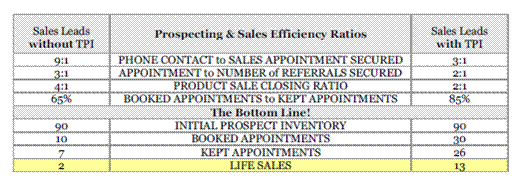- Home Page
- 8 Insurance Selling Tips
- Arranging Face to Face Meetings
Arranging Face to Face Meetings
Every article on this website is like a mini-training school. use the nav bars on either side of this page to locate your area of interest or subject you need help with.
What’s
So Difficult About Selling Life Insurance?
What’s
So Difficult About Selling Life Insurance?
Article # 4
Written by John Lensi CLU, ChFC, RHU, REBC, CMFC, LLIF
A Life insurance help library article
There are a
number of ways to get in front of someone to
conduct an interview.

You can make arranging face to face meetings easier.
when examining the various methods to
contact a prospect or drawing prospects in front of you (i.e.,
seminar), for the most part it boils down to a telephone contact from a
producer (or qualified marketing assistant) to arrange a favorable
meeting. In essence, the prospect must be convinced he or she can
potentially benefit from meeting with a life insurance sales
professional, or the interview does not get arranged.
Sticking with the telephone is generally the most often used method to
make contact with a prospect, a producer will find their ability to
influence a prospect to meet with them is directly linked with the
sales lead having TPI.
You should check out some of these free industry resources that are available to you.
TPI
is powerful.
Third
party influence occurs when a producer makes contact with
a prospect (this can be face to face or a telephone contact and is
able to gain the listening attention of the prospect through reference
to a third party known and respected by the prospect. [I’m assuming
there is no ‘do not call’ compliance issues associated with making
contact with the prospect.] Without TPI, few prospects will listen to
your pre-appointment message as to how the prospect can benefit from a
sit down meeting with a financial professional.
Conversions about life insurance (even if the words themselves aren’t
spoken) don’t generally excite consumers to want to meet with a
producer.
Last time I checked,
the
consumer thought process often went like this - “this person is just trying to sell
me something and I’m not sure I need or can afford any more insurance …
I’m not interested… in fact I’m all set.”
It’s often out of respect for the third party affiliation alone
prospects “with TPI” will listen to a producers appeal to meet with
them and agree to scheduling a favorable appointment. Without TPI, you
are just another pesky “salesperson” in the mind of the prospect. And
unfortunately, in the universe of sales people in general, consumers
tend to think life insurance sales people are more interested in
selling them something for their personal gain (commissions), then for
their own personal benefit.
The
Hour glass Syndrome.

What I have coined the “the hourglass
syndrome,” deals with time management efficiency and the measurement of
a sales persons “prospect contact to appointment secured” ratio being
directly linked to having qualified sales lead inventory. This is a
powerful concept and often identifies the cause of a financial services
producer’s failure in this business.
An ineffective
producer often
struggles as a result of prospect leads
being unqualified. This translates into poor activity ratios and of
course
poor sales results.
Often ineffective producers think their sales are down because of some other reason. Often, this is not the case.
Understanding this concept on arranging face to face meetings will benefit you in the long run.
Good
bookkeeping will help you see the truth.
Let’s
look at an example of what the numbers reveal..
To make this point
clearer, let’s say a typical
newer producer is able to make 15 telephone contacts with
their
sales leads per hour and is in need of 12 new business sales
appointments each week to meet his/her production objectives.
If a
producer continues to prospect and develop an inventory filled with
leads without TPI, their prospect contact to appointment secured ratio
may be in the area of 9:1 (I’m probably being generous here). Those
producers who control the source of their sales leads and who are
cognizant about the influence of TPI, will have a ratio in the area of
3:1.
Actual
results of course vary by producer. The point here is a
producers’ efficiency ratio will always be better if a qualified lead
fuels the sales process. This may sound elementary, but even seasoned
producers fall into the trap of developing poor prospecting habits and
often don’t correlate the real reason why they are in a sales slump.
Let’s take a closer look at the 3:1 and 9:1 ratios used above:
In a business where sales results (commissions) are linked to
efficiencies, the “9:1” producer above is nearly three times less
effective than the second producer. This may not sound like all that
big a deal, until you examine the ‘bottom line’.
The bottom line!
Looking at the chart below, Producer “A” on
the left below starts with 90 prospects and makes $1000 from all his
efforts. Producer “B” below also starts with 90 prospects – all
qualified sales leads – and makes $20,000 for his efforts {don’t get
hung up on the average case size, it’s the point I’m trying to make
that’s important for producers to understand}. Each producer in my
example started with 90 ‘prospects’, yet Producer B earned a great deal
more in commissions as a result of being more
efficient. The difference
stemmed from controlling the source of the sales lead inventory to
start the sales process.
Note that as a
result of TPI, all other producer efficiency ratios show
improvement – cancellation ratio; closing ratio; average size sale;
number of referrals obtained per appointment kept.


Footnote from Ted: The key to success in any business is good accurate record keeping. The reason that most business's fail in the United States is lack of good record keeping.
Here is an example of how arranging face to face meetings through with referrals worked for me.
During my first year in the life insurance business, My
record keeping identified the military market as my most efficient and
productive target market. I then specialized in that target market and
eventually became known on that military base as the foremost life
insurance agent to help young air force officers. But just like anything else, it
takes time and hard work. I would only work referrals. No cold calls.
See article number 5 where John will discuss:
The
Presentation and Selling Skills.
| Monthly Newsletter Free Please add me to your e-mail list so I can receive all new updates on selling and recruiting. See all back issues |
| Insurance Forum Get answers |
Follow Us
|
Our most popular Self Help e-books Exclusive to our readers |
Looking for proven and tested recruiting concepts. View our Agency Building Manual. |
| More free resources and helpful selling tools |
